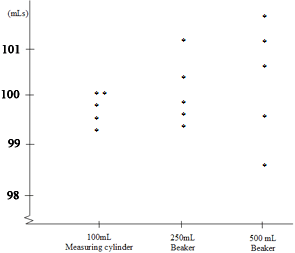Measuring volume with accuracy
This task is about measuring accuracy of equipment.

In groups of 3:
- Weigh each cylinder/beaker and write this in the table provided (column 2).
- Measure 100 mL of cold water into each piece of equipment.
- Weigh the piece of equipment with the water in it, and fill in columns 3,4 and 5.
- Repeat steps 1-3 four more times.
- Plot results from column 5 onto the scatter graph.
- Discuss the patterns with your group, then answer the two questions, c)i) and ii).
NOTE: 1mL of water weighs 1g
| a) |
|
|
b) |
Enter the results from Column 4 to complete the scatter plot. Mass of water in different containers  |
| c) |
i) Which is the most accurate piece of equipment? ______________________________
|
|
ii) Why do you think this piece of equipment was the most accurate?
|


